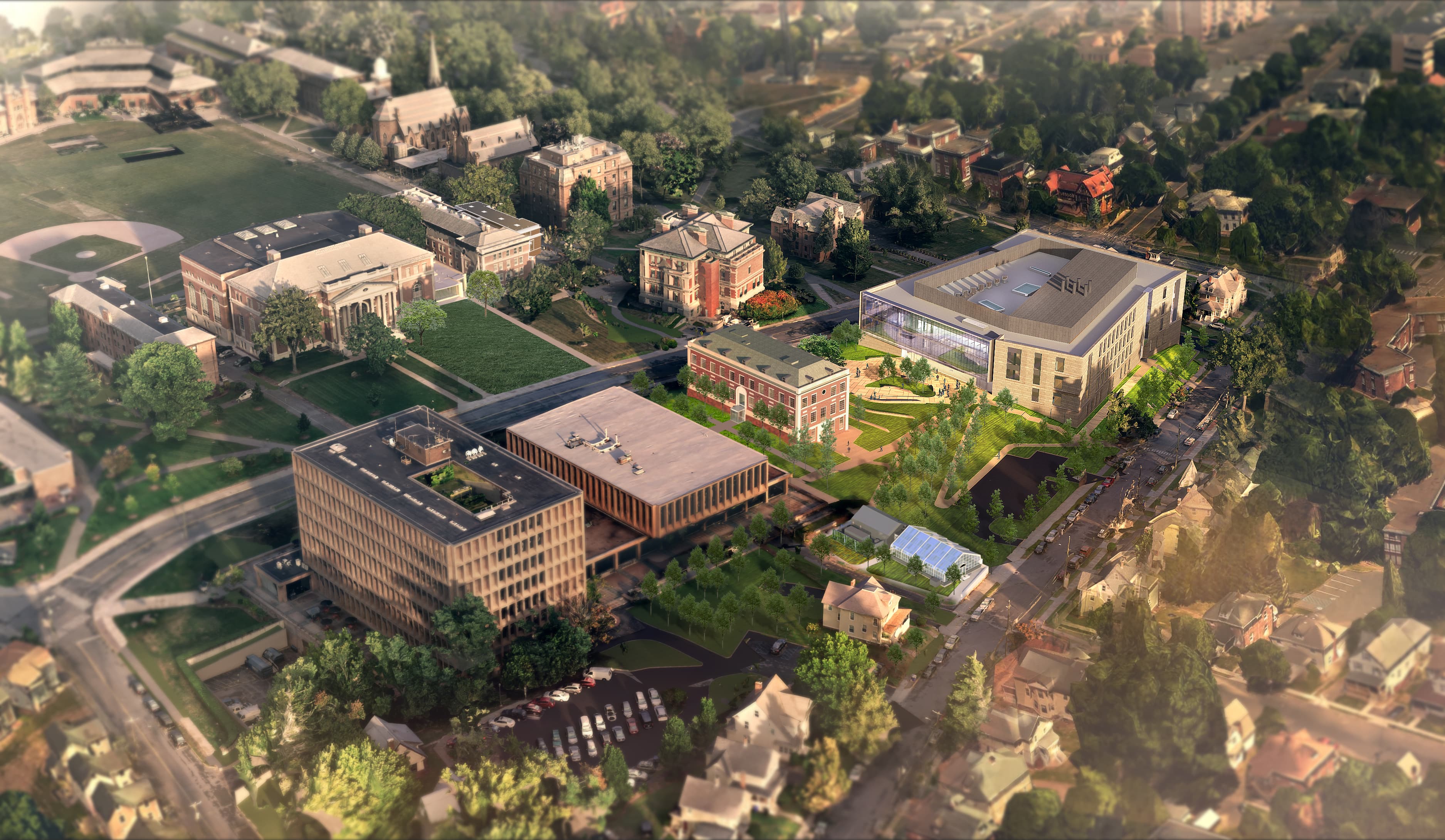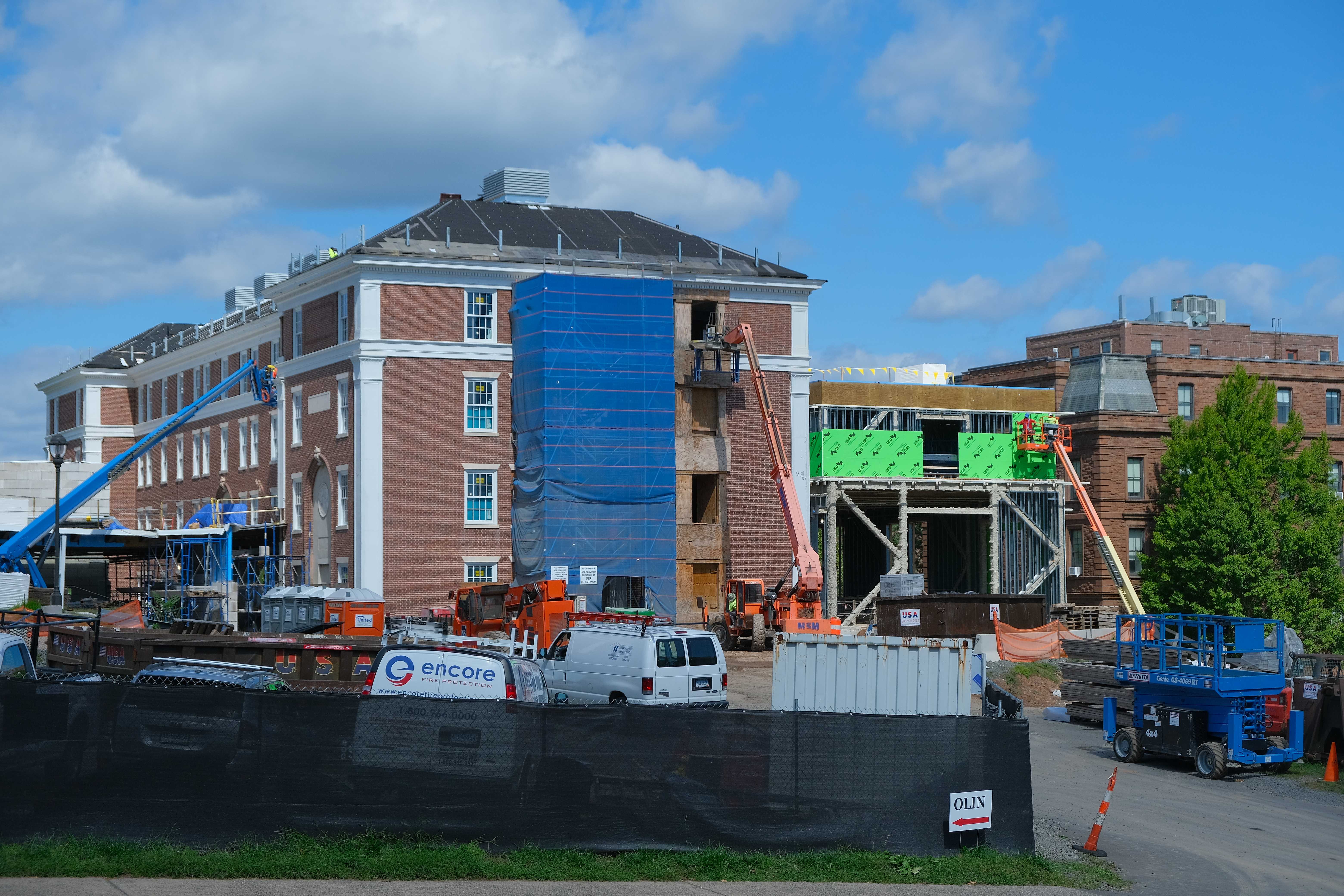

The University’s three major Construction Services undertakings—including the Public Affairs Center (PAC) renovations, new science building construction, and steam to hot water pipe conversion—are all on schedule as of the start of the Fall 2022 semester. The PAC, assuming the rate of progress remains steady, will reopen in Spring 2024, while the pipe project is on track for completion by Fall 2029. The new science building is set to open in 2026, and is currently pending final approval from the Board of Trustees. Pipe construction has concluded for the academic year and will resume next summer. During the school year, PAC and science building construction hours will be 7:00 a.m. to 3:30 p.m.
In the leadup to the Fall semester, while occupied with both of these projects as well as various facilities maintenance issues, the University made major headway on its steam to hot water pipe replacement initiative. This project, which many students do not see due to its timing in the year, has been an ongoing and major undertaking by Construction Services.
“Over the summertime, the big thing that was digging up all over campus was the hot water loop,” Construction Services Project Manager Joe Banks said. “We actually got ahead by a whole year on that project this year, both in terms of funding it and in terms of getting it completed. So while a lot of the campus was dug up over the summer, it’s all back in place, things are seated, and we’re ahead of the game on that project.”
As of now, the Center for the Arts, Boger Hall, Usdan University Center, North and South College, Fisk Hall, Allbritton Center, the PAC, Olin Memorial Library, and Clark Hall all have hot water heating. During the summer of 2023, Hewitts 8, 9, and 10 will be converted, followed by the rest of the dorms on Foss Hill in the summers of 2024 and 2025. The new science building will open with hot water pipes in 2026, Exley Science Center and the Butterfields will be converted in 2027 and 2028, and, finally, Freeman Athletic Center will round out the project in 2029.
Most of this pipe replacement work, President Michael Roth ’78 explained, is done over the summer in order to minimize its effect on the campus community.
“We really wanted to accelerate this work [replacing the pipes] because it’s the most important thing we can do to reduce our carbon footprint,” Roth said. “We got a lot done [over the summer] and with minimal disruption to most students.”
According to Assistant Vice President for Construction and Infrastructure Alan Rubacha, all of the University’s ongoing construction projects are on schedule, on budget, and injury-free thus far.
“There are always challenges whenever you dig into the earth or renovate an existing building,” Rubacha wrote in an email to The Argus. “Thankfully we have teams of professional architects, engineers and contractors to help make any surprise just a part of the process.”
The PAC, which sits in the center of campus between Olin and Judd Hall, has been under construction since June 2021. While many students have felt displaced by the construction or inconvenienced by the disruption it has caused to campus walking paths, this will likely change in the near future. Assuming everything remains on schedule, sidewalks around the PAC will be fully open in Fall 2023, according to the University.
“As construction proceeds on PAC, I think you’ll be able to see more and more clear areas to walk,” Banks said. “There’ll be less and less construction fencing. But keep in mind, all that is there for everybody’s protection. We and the construction manager are exceedingly cautious about making sure that we’re restricting access where necessary.”
Although parts of campus will once again be made available to students, the construction site around the new science building will likely remain the same for the coming years, with slight expansion. The construction boundary will be extended into the L Lot, which is situated between the Butterfields and High Street. In total, Rubacha wrote, four of the campus’ 370 acres are currently being taken up with construction projects.
Banks remarked on the potential impact of construction on student life and the University’s commitment to keeping the community informed.
“In terms of the science building, what you see now is likely to be what the campus will have for the next several years as this is being constructed,” Banks said. “It’s a major building, there’s gonna be a lot of work that happens, a lot of excavation, and a lot of materials being brought in…. The construction manager and Facilities Department here at Wesleyan will release logistics plans, as appropriate, to the Wesleyan community so that everybody understands what’s gonna be coming and when and where the fence lines will begin to change.”
The next major change in the science building’s construction will be the demolition of 34, 28, and 22 Lawn Ave., which previously served as program houses. Some pre-demolition has already begun on these buildings in preparation for the site clearing. Additionally, the Neighborhood Preschool—located at 20 Lawn Ave.—is also set to be demolished, with the preschool’s new facility slated for completion by Oct. 3, 2022. Once these structures have been cleared, the University will begin digging the new science building’s foundation.
“If you’re in the Religion Department or the Resource Center, it is going be noisy for some time, but once the first part of construction is done, the noise levels should reduce,” Roth said. “We’re trying our best to make a really great building, which would be the largest one on campus, and do it in a way that isn’t too disruptive. So, we want to keep our eye on that.”
To minimize disruption to student life and academic proceedings, Hall-Atwater Laboratory will not be demolished until construction on the new science building is complete and the facility is open.
“The new science building will be constructed and open [in 2026] at which point Hall-Atwater and Shanklin programs will be moved into the new building,” Rubacha wrote. “After that move Hall-Atwater will be demolished and Shanklin renovated…. The houses will be demolished by Thanksgiving and excavation will commence in late October.”
According to Rubacha, no existing elements of Hall-Atwater will be recycled or repurposed into the new science center, distinguishing it from existing campus architecture. Between the renovated Shanklin and the new science building, the current number of classrooms will nearly double.
“We know it will be a much more efficient building [than Hall-Atwater], not only in terms of energy usage, but also for classes and research,” Roth said. “It will be much more flexible.… It’ll be a much more contemporary way of using the spaces.”
Roth hopes that the science building, which will be the culmination of many years of funding initiatives, will become more than just an austere classroom space for the student body.
“We also want it to be a crossroads between Butterfield[s] and College Row,” Roth said. “It’s not just for people taking a science class, just like Pi Cafe has made the lobby of Exley, over the last five or six years, a place for people to go. You don’t have to show your card that says, ‘I’m a biologist’ or ‘I’m a computer scientist.’ I think that that’s our expectation for the new science building, so the diversity, equity, and inclusion work on that building has been pretty intense to make sure it’s as welcoming as possible, and that it’s hospitable to Wesleyan students, whatever they study.”
Though both Banks and Rubacha expressed enthusiasm for the upcoming completion of the PAC and science building, they too feel the process of construction itself has benefited the wider Middletown community. Rubacha expressed his team members’ interest in the University’s success, as well as their gratitude for students’ attitudes.
“Please know how excited all of our construction teams are to participate in construction on campus,” Rubacha wrote. “Our construction projects currently employ 120 trades regularly and they are…excited to be on campus…. [T]his work has an enormous impact on local trade [employment]…. We appreciate the patience of everyone on campus.”
Detailed information about Construction Services’ plans for the year can be found on its website, as well as on the 2022/2023 site planning Google map.
Sam Hilton can be reached at shilton@wesleyan.edu.
Maxwell Maveus can be reached at mmaveus@wesleyan.edu.


Leave a Reply